Luteochaete subglobosa (Sheng H. Wu) C.C. Chen & Sheng H. Wu, in Chen, Chen & Wu, Fungal Diversity 111: 425 (2021)
MycoBank number: MB 840790; Index Fungorum number: IF 840790; Facesoffungi number: FoF 12595;
= Phlebia wuliangshanensis C.L. Zhao, Mycotaxon 135:111. 2020. (syn. nov.)
Basionym: Phanerochaete subglobosa Sheng H. Wu, Acta Botanica Fennica 142:49. 1990.
Description: Basidiocarps annual, broadly effused, adnate, subceraceous to coriaceous, up to 120–1000 μm thick in section. Hymenial surface ivory yellow or pinkish buff when young, cinnamon-buff when old, slightly greenish yellow in KOH, smooth, sparsely cracked in dry; margin paler or white, thinning out, arachnoid or pruinose. Hyphal system monomitic; generative hyphae simple-septate. Subiculum fairly uniform, with compact texture, up to 250 μm thick; hyphae horizontal, colorless or yellowish, 4–16 μm diam, with 0.5–2 μm thick walls, moderately ramified, densely interwoven, fairly straight, usually somewhat flexuous near subhymenium. Hymenial layer distinctly thickening, subhymenium clearly differentiated from subiculum, with compact texture, up to 750 μm thick; hyphae vertical, colorless, 2–5 μm diam, with thin to up to 0.7 μm thick walls, richly ramified, densely interwoven, flexuous, ± agglutinated, fairly short-celled, distinctly narrower than those in subiculum, usually irregular inflated at septa; hyphal anastomoses occasionally present. Lamprocystidia 45–85 × 6–10 μm (with encrustation), with 0.3–1.7 μm thick walls, numerous, subulate or cylindrical with acute or obtuse apices, heavily encrusted, originating from hymenial layer, immersed or projecting for approximately half their lengths, occasionally with one adventitious septum. Basidia 24–33 × 4–7 μm, subclavate, thin-walled, 4-sterigmate, usually guttulate. Basidiospores broadly ellipsoid or subglobose, colorless, thin-walled, smooth, usually with 1–2 yellowish oily drops, inamyloid, nondextrinoid, acyanophilous, mostly 5.3–6 × 3.3–3.8 μm. (5–)5.3–6(–6.4) × (3.1–)3.3–3.7(–3.9) μm, L = 5.7 μm, W = 3.5 μm, Q = 1.62 (n = 60) (GC 1605- 4). (4.7–)5.3–5.8(–6) × (3.3–)3.5–3.8(–4) μm, L = 5.5 μm, W = 3.7 μm, Q = 1.52 (n = 30) (isotype).
Specimens examined: TAIWAN. Taichung City, South District, National Chung Hsing University, 24°07ʹ N, 120°41ʹ E, 87 m, on angiosperm trunk, 11 May 2016, C.C. Chen, GC 1605-4 (TNM F30796); Taipei City, Natioanl Tai- wan University, on bark of living Melaleuca leucadendron, 18 Sep 1987, S.H. Wu, Wu 870918 (isotype of P. subglobosa, TNM F21743).
Ecology and distribution: On living or dead angio- sperm trunk (e.g., Avicennia schaueriana and Melaleuca leucadendron), SW China (as Phlebia wuliangshanensis), Brazil (as Phanerochaete subglobosa) and Taiwan, May to Oct in East Asia, Dec in Brazil (Baltazar et al. 2017; Huang et al. 2020b).
Notes: Luteochaete subglobosa is characterized by having yellowish basidiocarps with smooth hymenophore, distinctly thickening and dense hymenial layer, compact subiculum with thick-walled hyphae distinctly wider than those in hymenial layer (4–16 μm), the presence of lamprocystidia (45–85 × 6–10 μm), and broadly ellipsoid or subglobose basidiospores (5.3–6 × 3.3–3.8 μm). Phlebia wuliangshanensis from China is conspecific with this species based on morphological and phylogenetic evidence (Fig. 6). Phylogenetically, Luteochaete sp. (RLG-13514-Sp and FP-110129-Sp), originally labeled as ‘Phlebiopsis’ cf. ravenelii on GenBank, was sister to L. subglobosa (Figs. 1, 3.6). The specimen RLG-13514-Sp was found on Platanus from Louisiana while FP-110129-Sp on Fraxinus pennsylvanica log from Mississippi according to the CFMR data- base (https://www.nrs.fs.fed.us/tools/mycology/). However, we did not study these specimens.
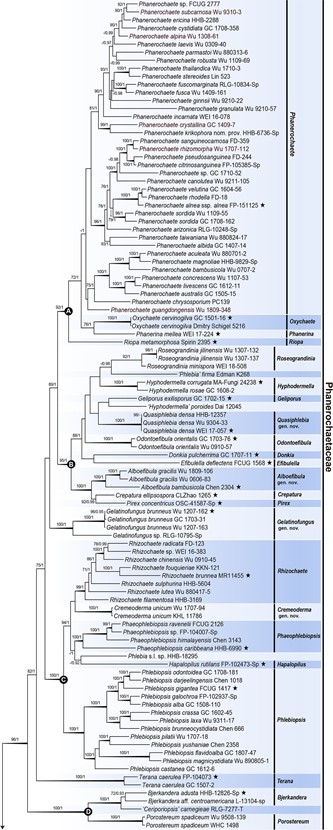
Fig. 1 The phylogram of the phlebioid clade (Phan- erochaetaceae, Irpicaceae, Meruliaceae) of Polypo- rales inferred from ML analyses using the combined ITS + 28S + rpb1 + rpb2 + tef1 dataset. Branches are labelled with ML BS ≥ 70% and PP ≥ 0.9 from Bayesian analyses. Thicken branches indicated both ML BS ≥ 95% and PP ≥ 0.99 from Bayesian analyses. Line- ages labeled A–J represent the Phanerochaete, Donkia, Phlebi- opsis, Bjerkandera, Trametop- sis, Ceriporia, Hydnophlebia, Sarcodontia, Mycoacia and core Phlebia lineages, respectively. Black stars (★) represent for strains of generic type species. Bar = substitutions per site
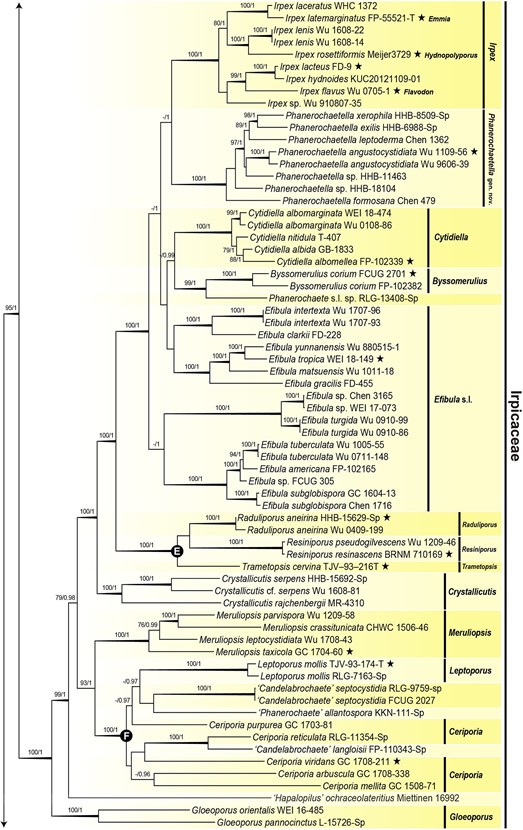
Fig. 1 (Continued)
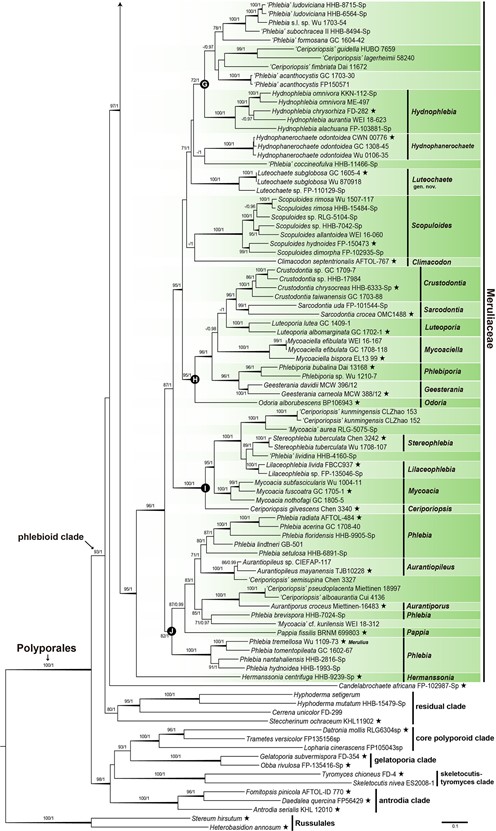
Fig. 1 (Continued)
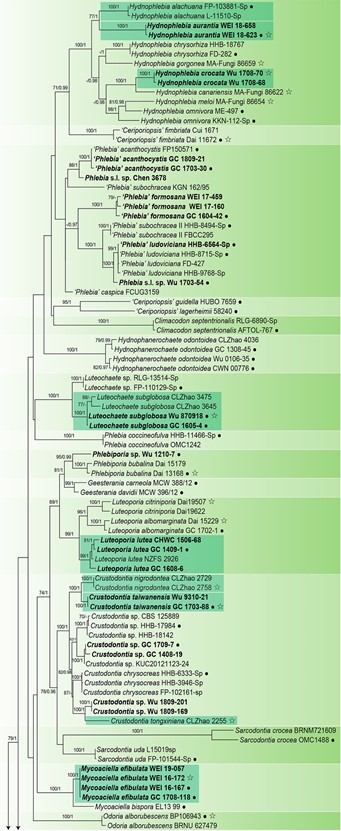
Fig. 6 The phylogram of Meruliaceae inferred from ML analyses using the combined ITS + 28S dataset. Branches are labeled with ML boot- strap ≥ 70% and BPPs ≥ 0.9 from Bayesian analyses.
New combinations or newly described taxa are shown in green boxes. White stars (☆) represent for holotype or isotype. Black circles (●) represent for strains included in the 5-gene dataset. Sequences newly generated in this study were shown in bold. Bar = sub- stitutions per site
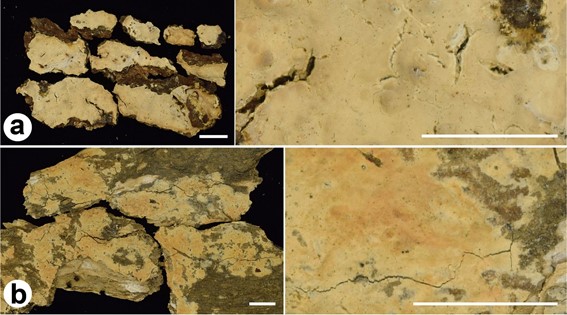
Fig. 48 Basidiocarps of Luteochaete subglobosa in general and detailed views. a GC 1605-4. b Wu 870918, isotype. Bars = 10 mm

Fig. 49 Micromorphological features of Luteochaete subglobosa (drawn from GC 1605-4). a Part of vertical section from hymenial layer. b Part of vertical section from subiculum. c Hyphae from hymenial layer. d Subicular hyphae. e Lamprocystidia. f Basidia. g Basidiospores
